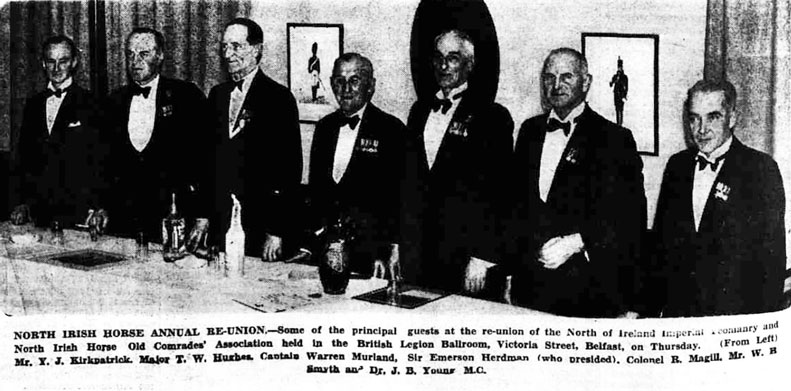Lieutenant James Bailey Young, MC

James Bailey Young was born on 28 September 1893 in Antrim, son of weighmaster Robert Young and his wife Margaret Young (nee Bailey).
He was educated at the Academical Institute, Belfast, and on the outbreak of war was serving an apprenticeship as a chemist's assistant to a Mr Wilson of 187 Albert Bridge Road, Belfast.
Young enlisted in the North Irish Horse at Antrim on 5 January 1915 (No.1382). He was made lance corporal on 2 June, corporal on 28 July, lance sergeant on 18 November, and sergeant on 18 December.
On 11 January 1916 he embarked for France as part of E Squadron of the North Irish Horse.
On 28 December 1916 he applied for a commission, his regimental commander Lord Cole, supporting the application, noted "This N.C.O has done good work & is thoroughly capable of commanding men." Young reported for duty at the No.1 Cavalry Cadet School, Netheravon, on 22 February 1917, and on 16 April was commissioned as a second lieutenant. Unusually, Young was posted to the regiment in which he had served in the ranks – the North Irish Horse.
After serving at the regimental reserve at Antrim through 1917, he embarked for France on 30 January 1918. On 26 April he was attached to the 9th (North Irish Horse) Battalion, Royal Irish Fusiliers, where he joined 108 Brigade's Light Trench Mortar Battery.
Young was wounded in the right forearm during an action near Becelaere, Belgium, on 30 September 1918. A detailed description of the action can be seen here. The battalion lost 147 killed, wounded or missing during the actions of 28 September to 1 October.
Young was later awarded a Military Cross for his gallantry during this action. The citation reads:
For conspicuous gallantry and devotion to duty south-east of Dadizeele on 30th September, 1918. He brought his trench mortar into action in the open under heavy machine-gun fire 250 yards from a farm. When his base plate broke, he stood up and held the mortar until all his ammunition was fired, putting a machine gun out of action. He then used his team as infantry and joined in the attack protecting a flank. He was eventually wounded, after much good work.
After treatment at the No.14 General Hospital at Wimereux, France, Young was sent to England, where he was admitted to the Military Hospital at Devonport. Meanwhile, on 17 October, his promotion to the rank of lieutenant came through.
The wound healed well and after a few weeks leave at home, Young rejoined the North Irish Horse reserve regiment at Antrim.
He was demobilised on 25 July 1919 and relinquished his commission on 1 April 1920.
After the war Young studied medicine at Queen's University, Belfast. He was registered as a surgeon on 28 March 1930.
Due to an administrative oversight, his medals, including his Military Cross, were not sent to him. It was only in 1958, when he wrote enquiring as to their whereabout, that the error was corrected. The medals were produced and sent to his address, 'Romonov', 281 Ormeau Road, Belfast.
Dr Young died on 21 December 1966 and was buried in Knockbreda Cemetery, Belfast.


Letter to Young's mother from North Irish Horse Captain and Adjutant Thomas Aston

Lieutenant Young, far right, Belfast News-Letter 12 November 1938

First image from my collection. Second image and letter kindly provided by James Bailey Young's son Frank. Gravesite image sourced from Billion Graves website.
